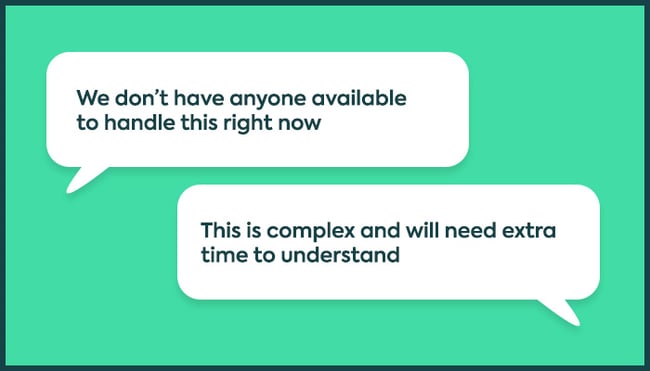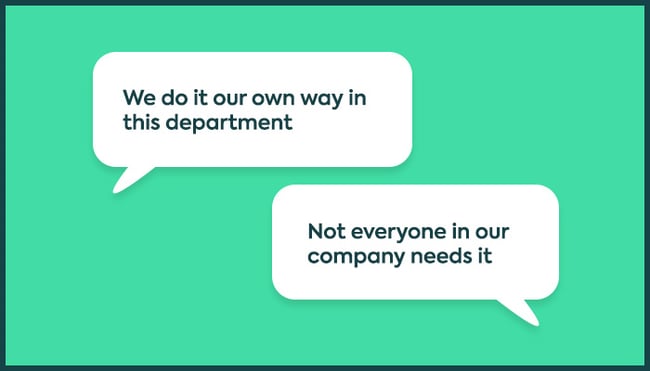If you're here, you’ve probably done your research on Hybrid Mail. You understand the cost savings, operational efficiency and freed-up resource that it brings. And you’ve found a great service provider.
There’s just one blocker – convincing the rest of your organisation to give it the greenlight.
Doesn't sound like you? Then take a look at our comprehensive guide to Hybrid Mail first – to learn what it is used for, the type of features available, and the benefits it can deliver.
Building a business case for a new Hybrid Mail solution is the tricky part. In our experience, this is where that quick and simple implementation clients hoped for sometimes fails to materialise.
The solution to the obstacles is often down to one thing – education.
Stakeholders often don’t fully appreciate the benefits of Hybrid Mail or how simple it is to implement. At least not straight away.
It’s important to get everyone on board and bought in as early as possible so you and your team can start saving time, money and resource.
So we’ve put together this handy guide to help you persuade senior stakeholders, and, depending on which team you sit in, your colleagues in IT, testing, procurement and operations. Here are the most common obstacles to adopting Hybrid Mail and how to overcome them.

We find that the biggest obstacle to a “yes” is a general misunderstanding of Hybrid Mail, how it works and how it is implemented.
This is particularly critical when it comes to your IT team and their testers. They have the power to stop the implementation in its tracks, as they are the ones who install and test the Print Driver.
If they are stretched, anything new could go to the bottom of the support ticket queue.
“It’s not as complex as you might think”
It’s important that your partner manage expectations and clearly advise what IT resource they need access to as part of the implementation.
The reality is that your Hybrid Mail service provider will do all the heavy lifting. All your IT team need to do is install a Print Driver across your estate.
And if there is still a hesitance, make sure they know there are short-term workarounds to get you up and running, like logging into a console to send direct submissions, enabling hot folders and deploying less intrusive MSI installers.
By bringing your IT team into the buying process early on, you and your new partner can show them that it really doesn’t take up as much time as they think. Normally everything is installed and tested within a week.

If your organisation has multiple departments with a different level of need for Hybrid Mail, your efforts to persuade them to adopt it will invariably have a varied amount of support.
Some departmental heads are unlikely to use the new Hybrid Mail service regularly, they may object to taking time to learn something that makes little difference to their own teams’ day-to-day activities.
Others may have their own way of doing things, and be reluctant to embrace change.
“Our staff will benefit from a superior experience with very little disruption”
Hybrid Mail will always be a more efficient way to send day-to-day, customer communications.
To overcome the “not-broke-don’t-fix-it” paradigm, it’s about making the benefits relatable.
Hybrid Mail will save 3-5 minutes of staff time per document. If you send ten documents a day, that’s nearly an hour a day. About 22 days a year, or one month of working time.

The staff will thank you for giving them back that time to do what they were actually hired for, and so will their managers when they realise that their staff are now able to concentrate on core day-to-day activities.
To silence the objections about time and resources spent training up the team, you can echo the point made to IT. Implementation will only require minimal input from your staff. Your partner will complete the bulk of the work on your behalf and they will clearly highlight any tasks that you would be responsible for completing.
A good vendor will train up “super users” across your organisation and give admin rights to designated staff, usually in operations teams. Once trained, they can then gradually educate the rest of the team over the weeks and months.
Your vendor will also know how to speak at different levels of expertise. The more tech-savvy departments, like IT and testing, will get technical documentation and deployment guides. Procurement and operations will get easily digestible marketing collateral to clearly explain the process.

There is resistance to change in every organisation.
While you may understand the benefits of adopting a Hybrid Mail solution, many stakeholders might need a little more convincing. They need a reason to believe.
“Here’s your proof”
First, remember to always have the benefits of Hybrid Mail in your back pocket.
When it comes to cost savings, it can often sound too good to be true. We’ve built our own calculator so you can prove the potential impact with numbers.
If anyone asks about setup costs, expect to pay between £1k-£5k for initial implementation and then a simple charge per pack – which will vary depending on envelope size, postage tariff, weight etc.
This is far cheaper than setting it up yourself, and as you can see with the calculator, you will always save more than you spend.
And for those who need more convincing, it’s good to show them real-world examples.
We recommend taking a look at the Allianz case study below. They are a client of ours who have successfully adopted Hybrid Mail across multiple offices and are saving 40% in costs in comparison to managing this in-house.
Education, education, education.
When your colleagues truly understand the potential of Hybrid Mail. When they can see that it needn’t be difficult to implement. And when they feel part of the discussion from the beginning.
In our experience, those are the simplest projects to sign off and set up. Your service provider is there to help. So don’t be afraid to lean on them!